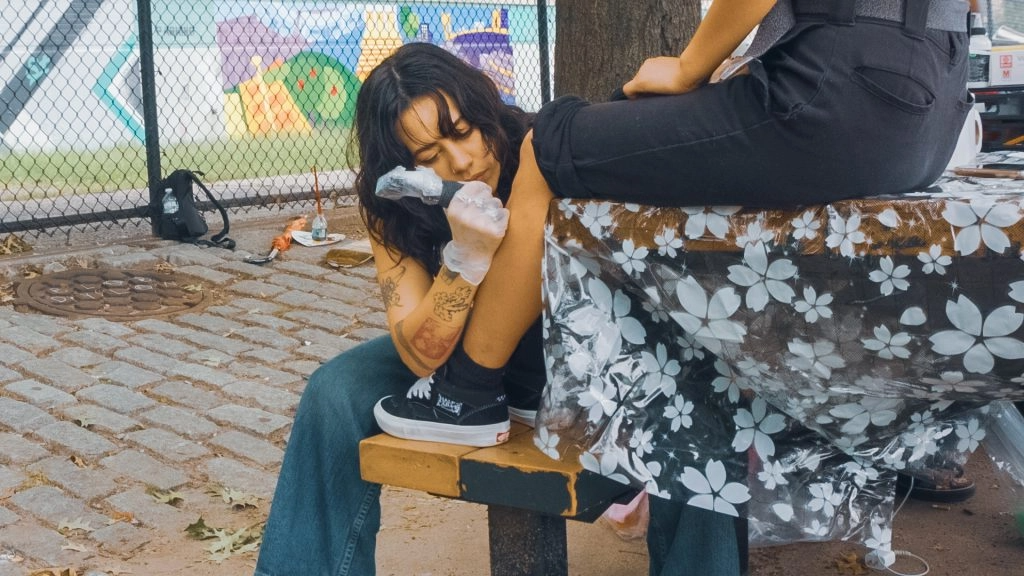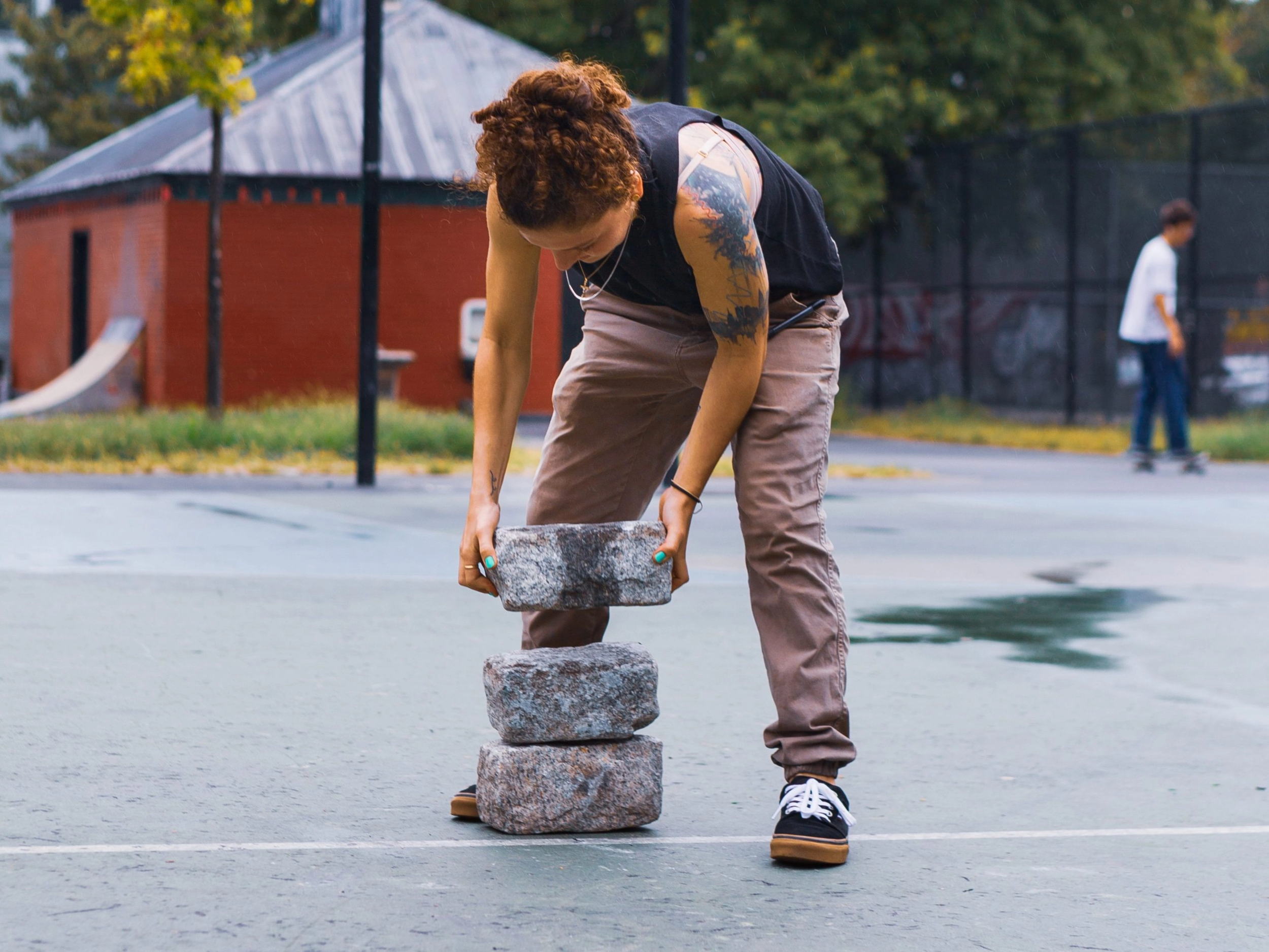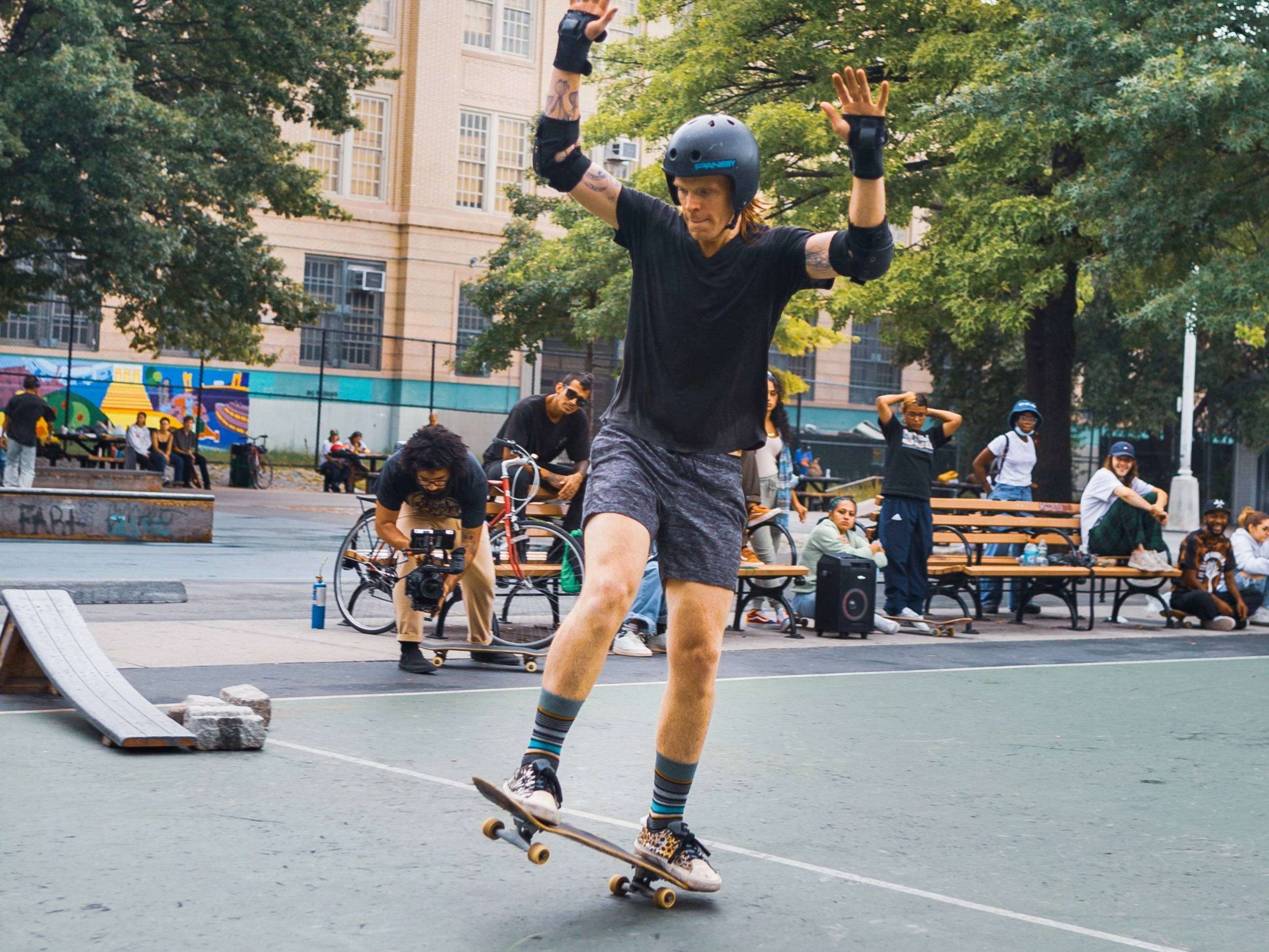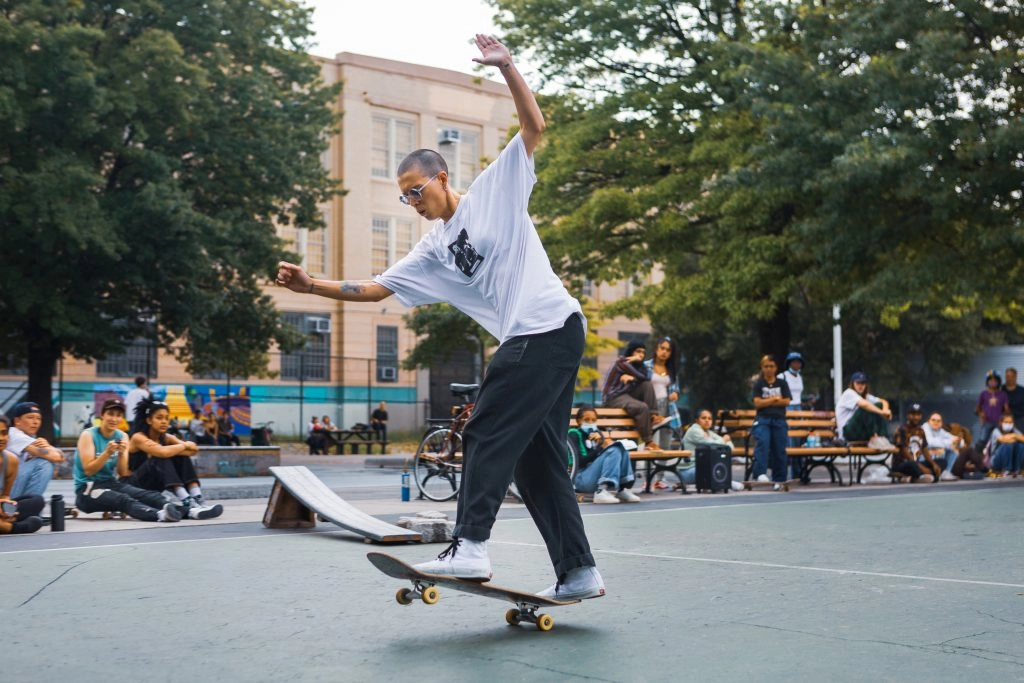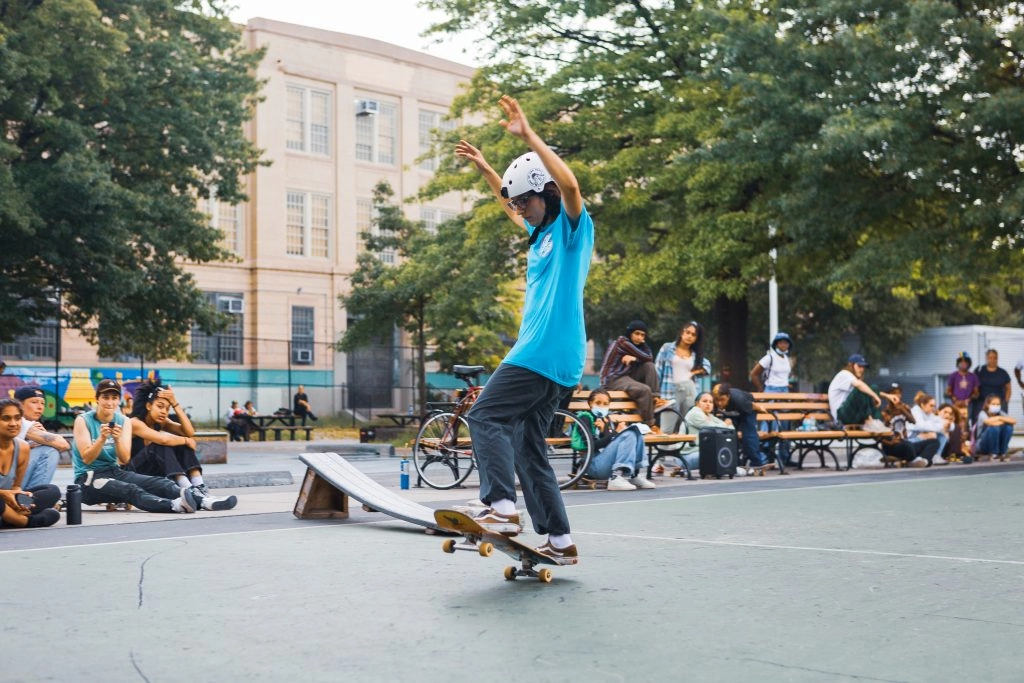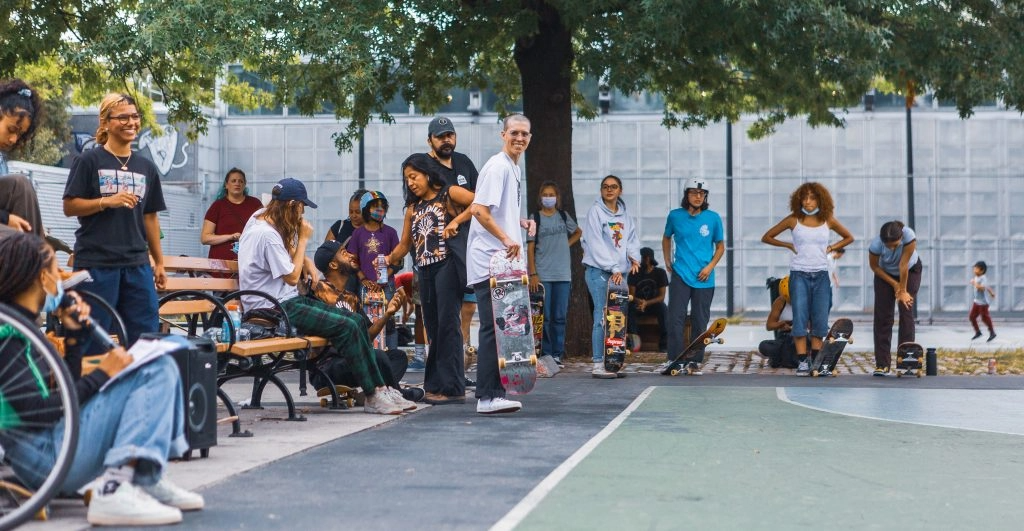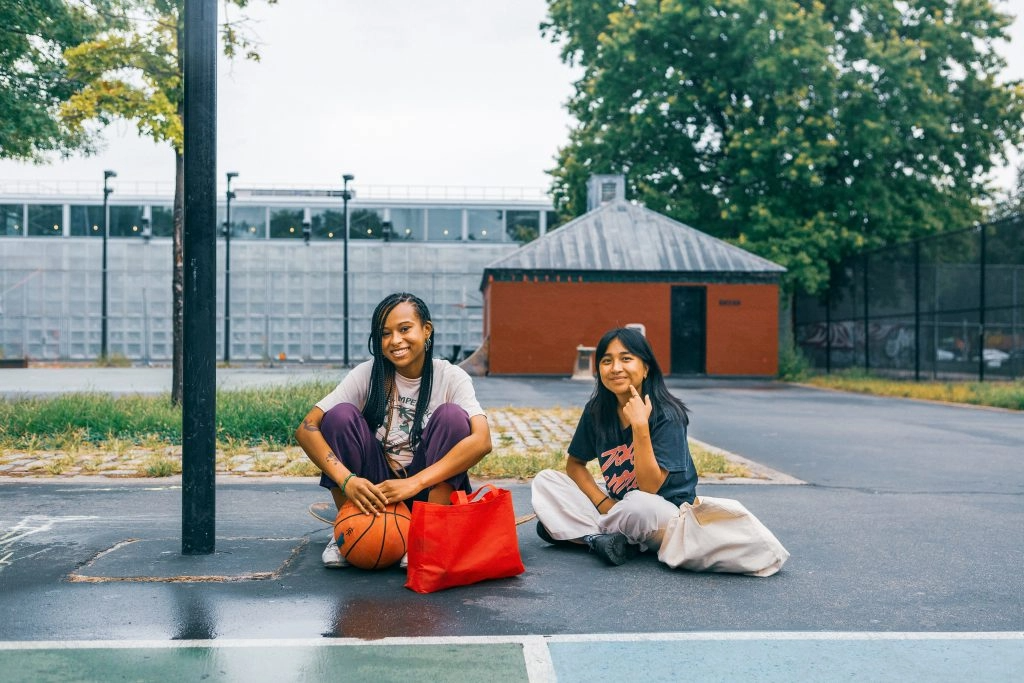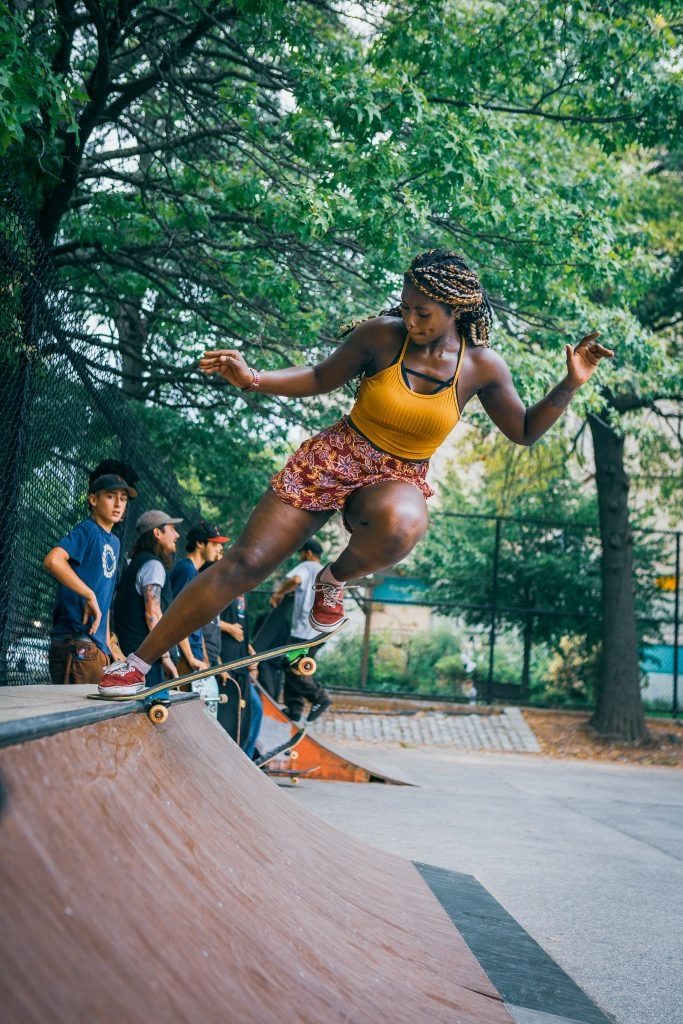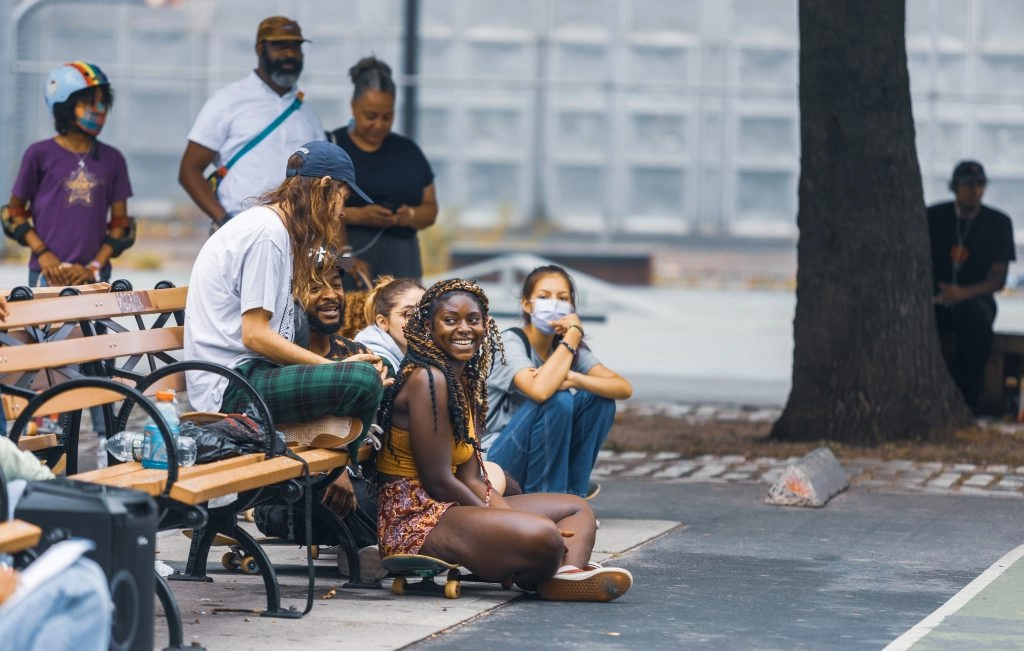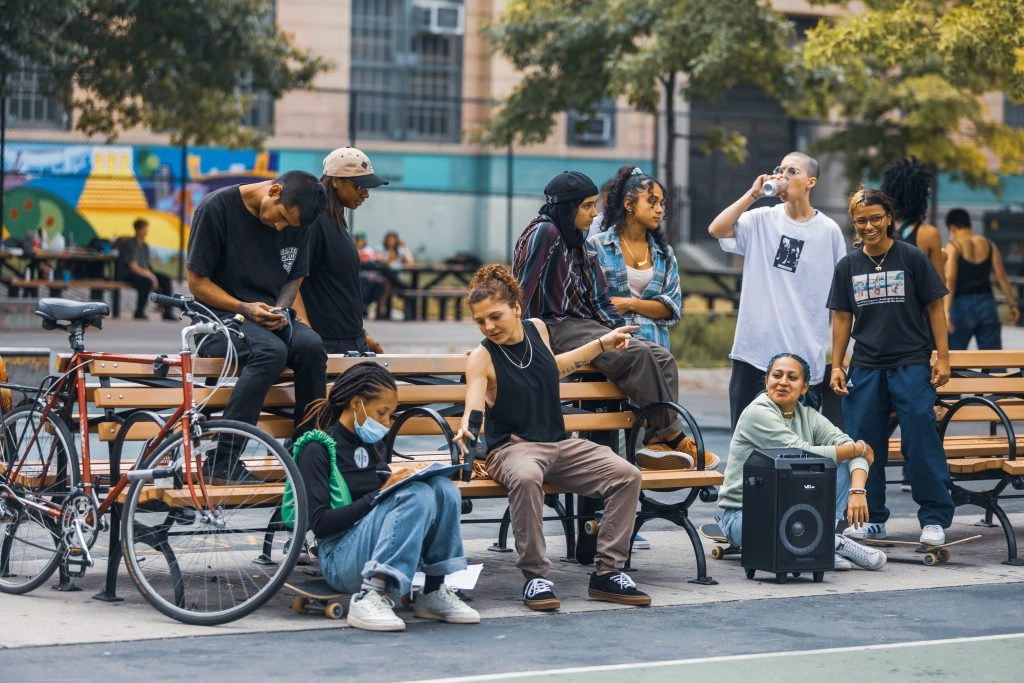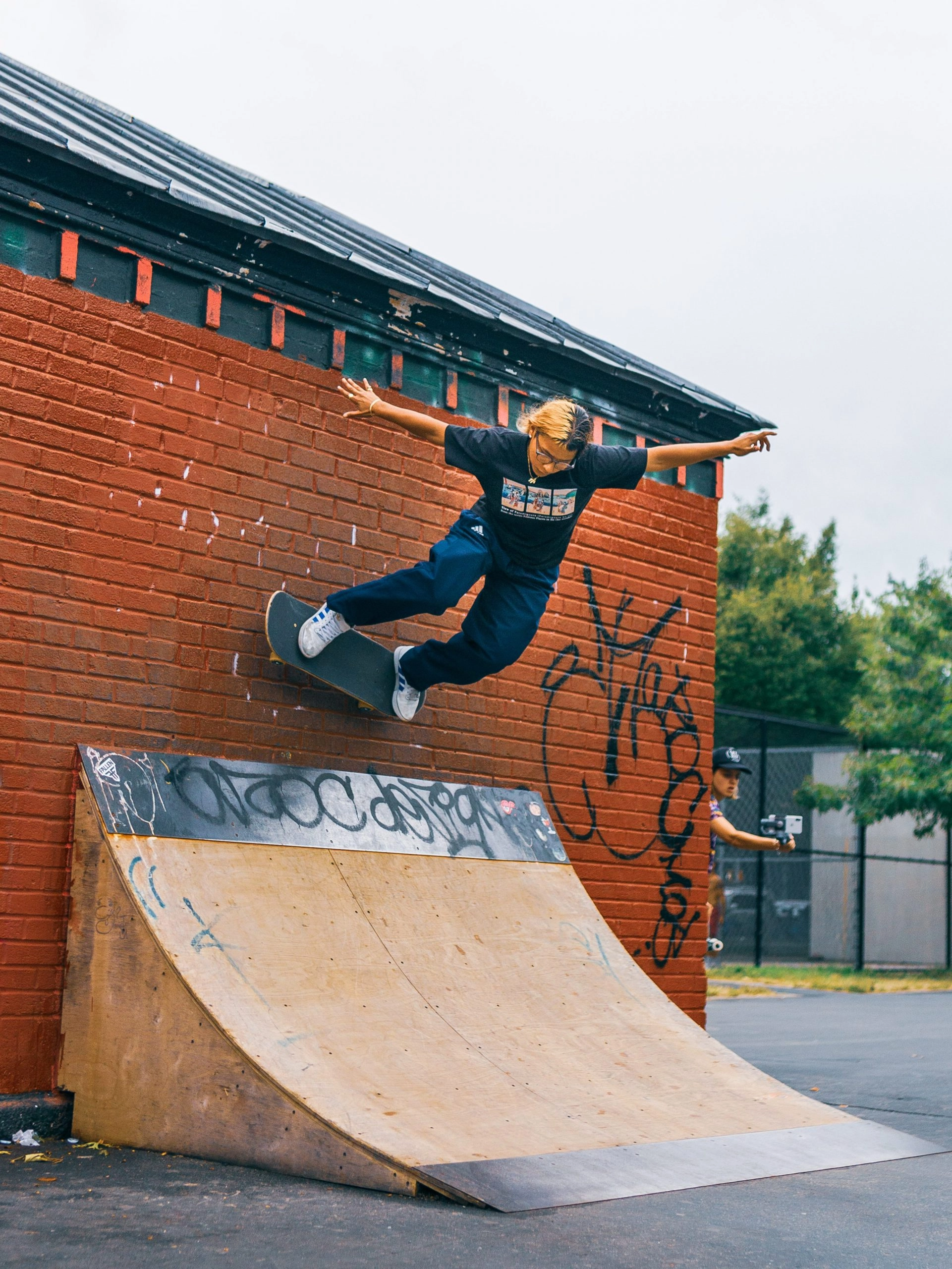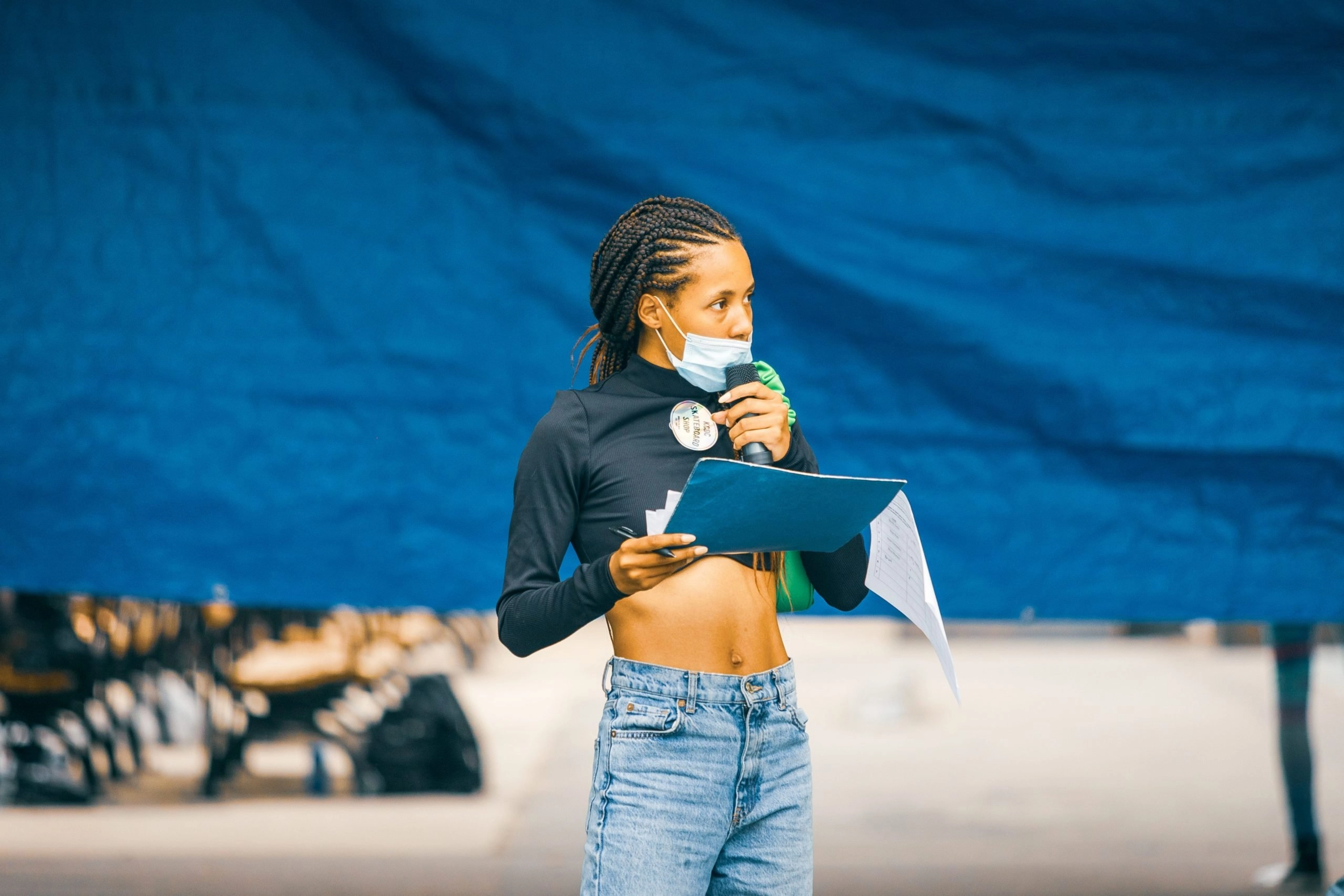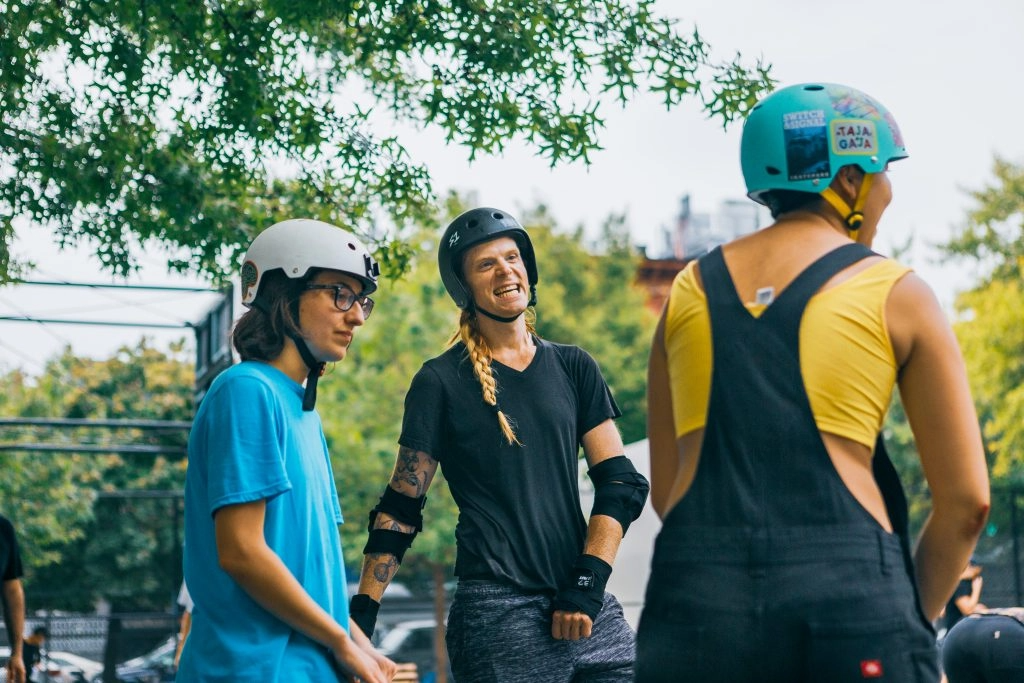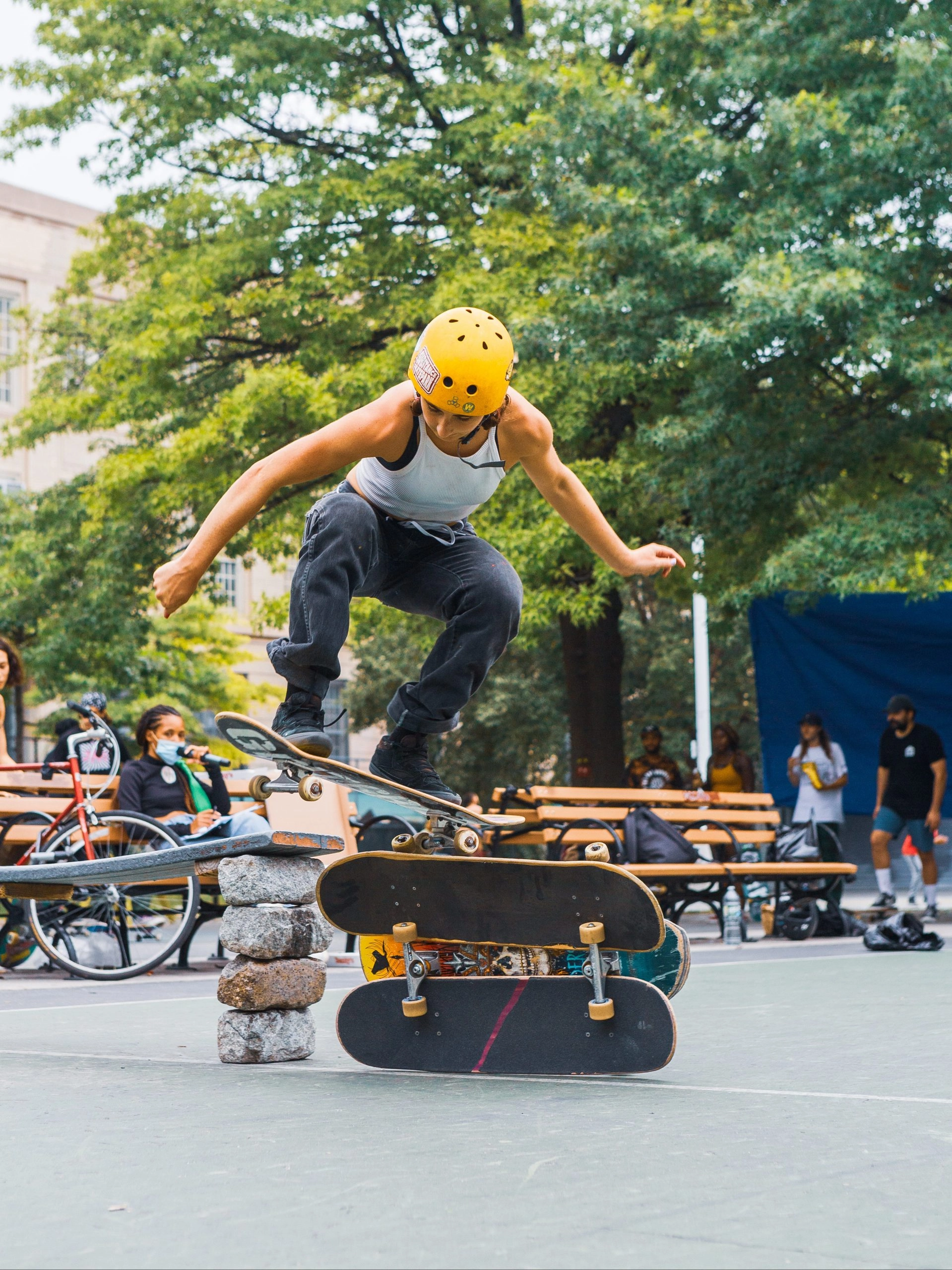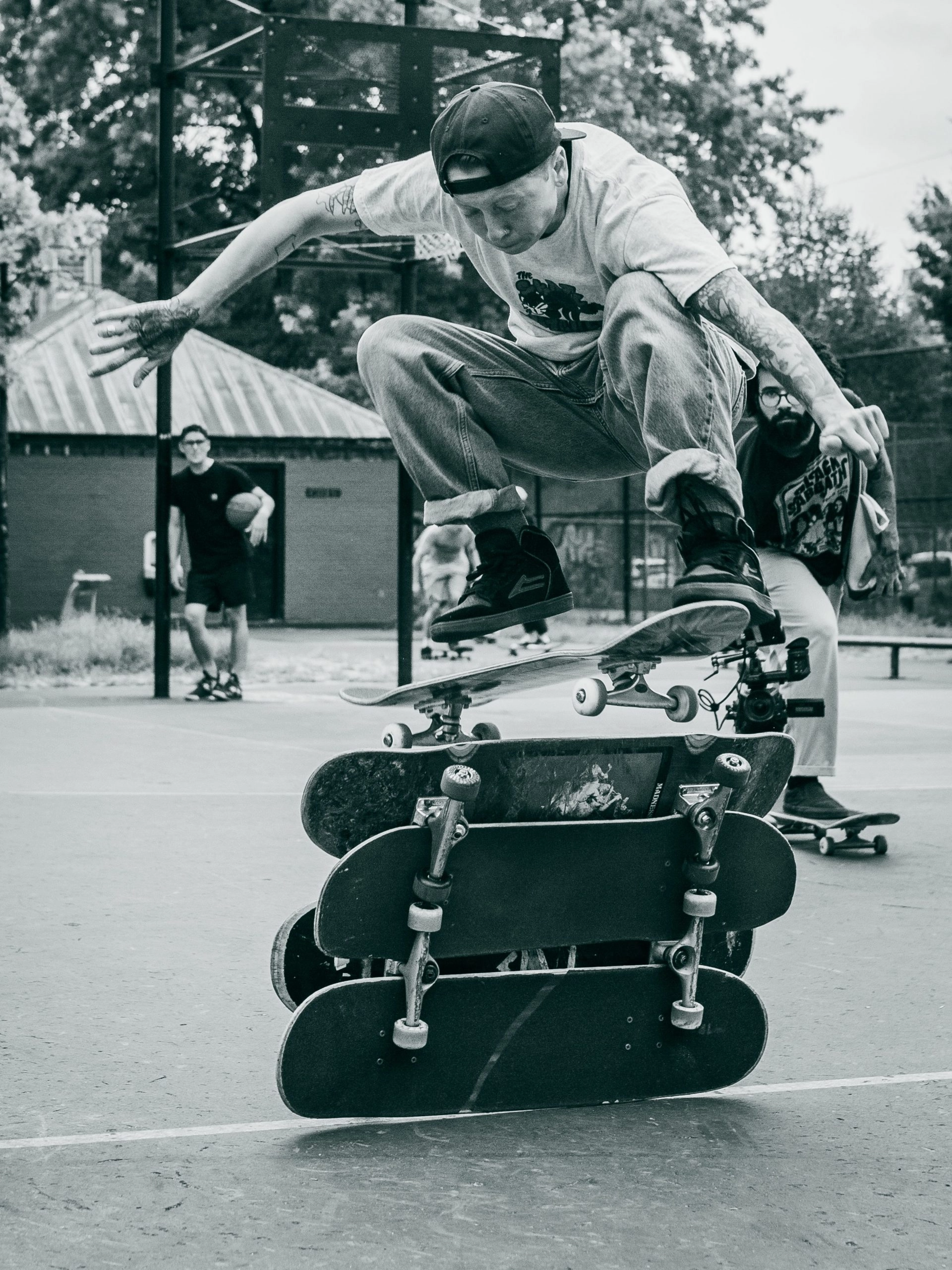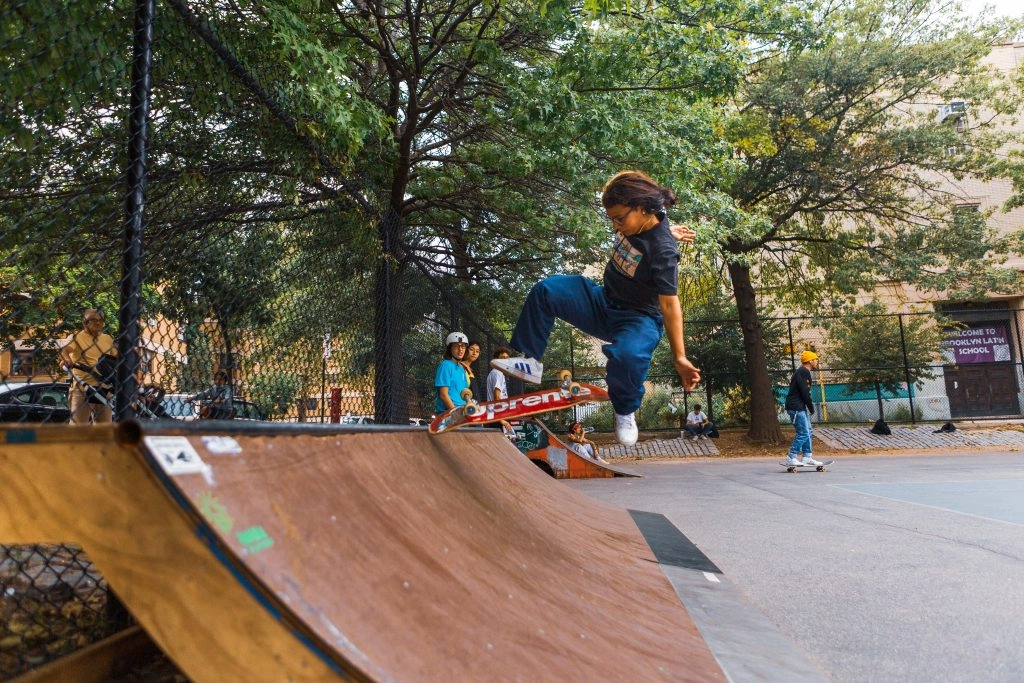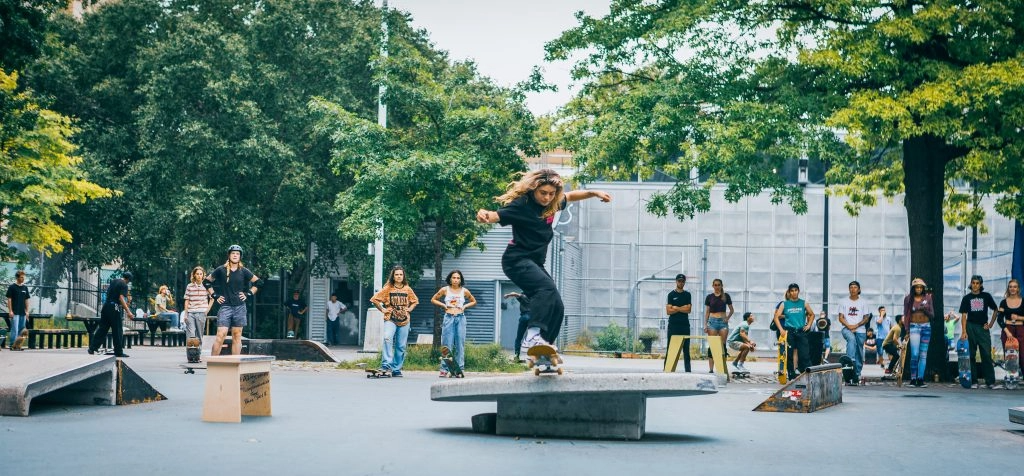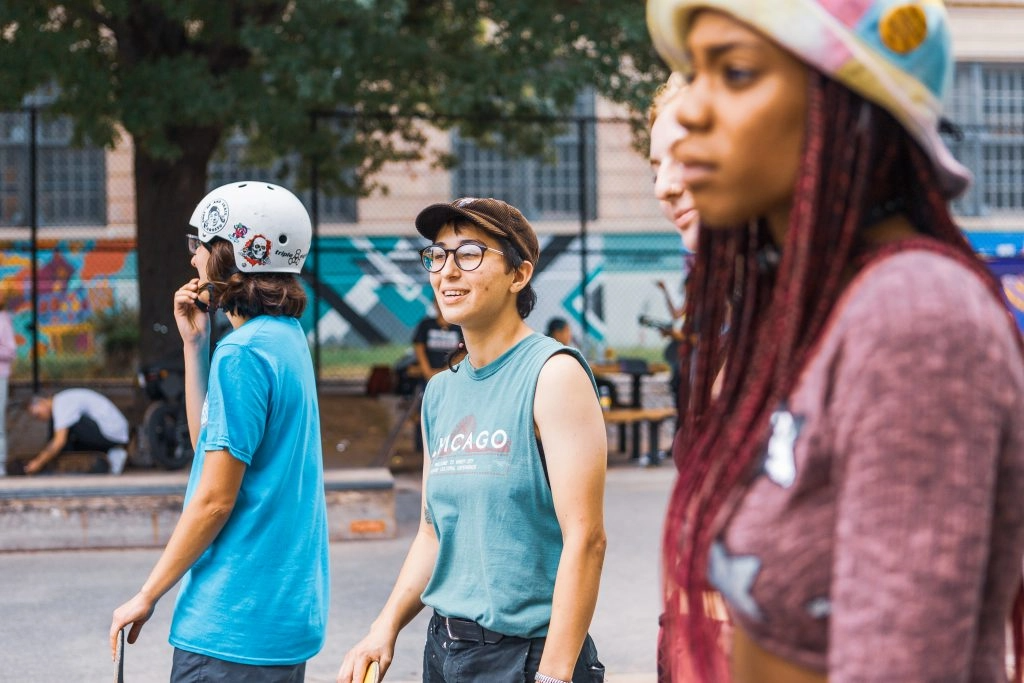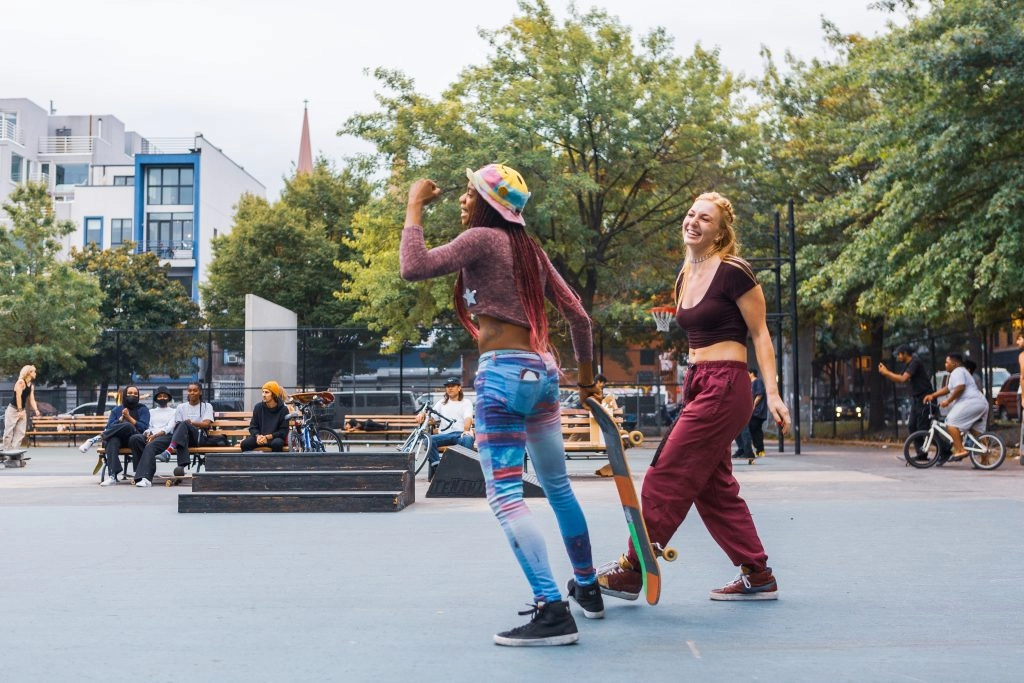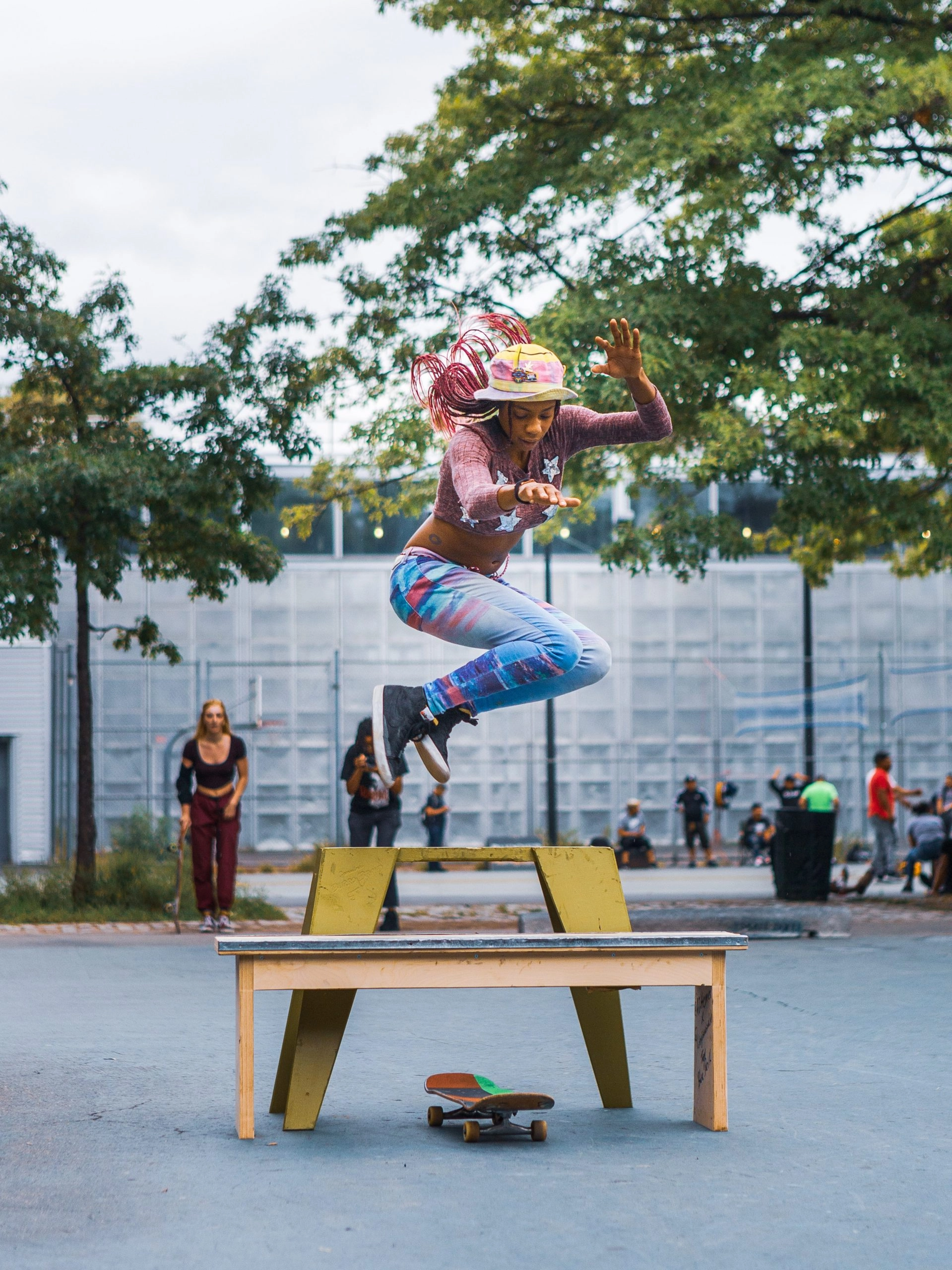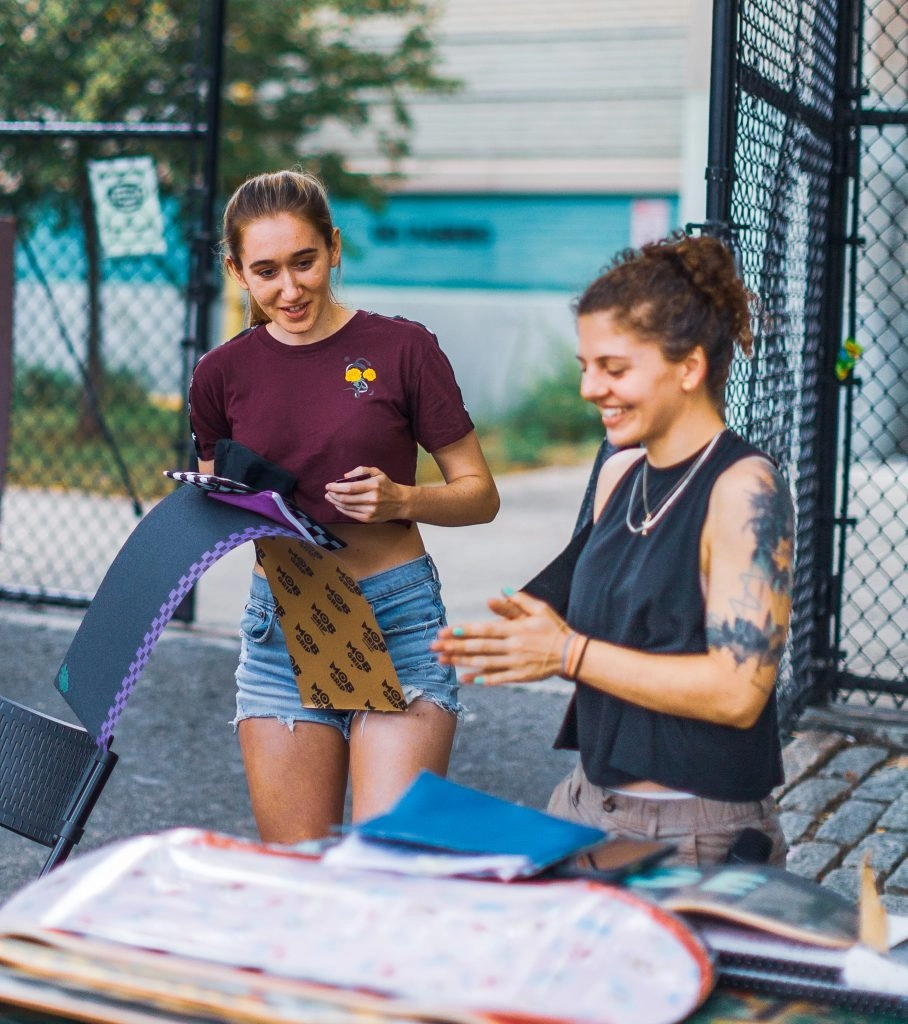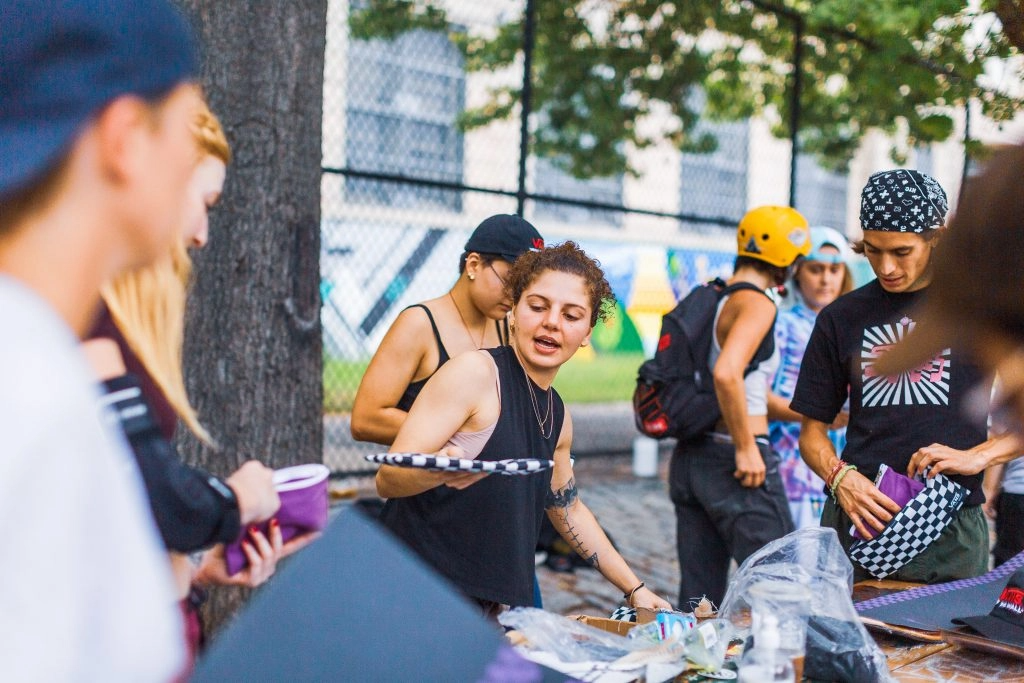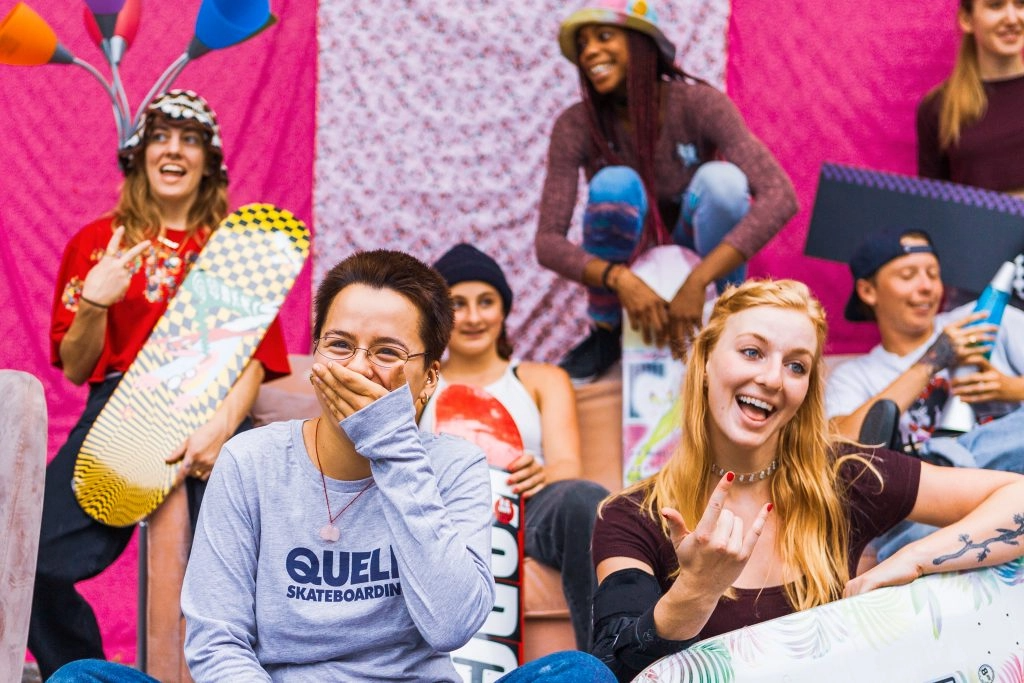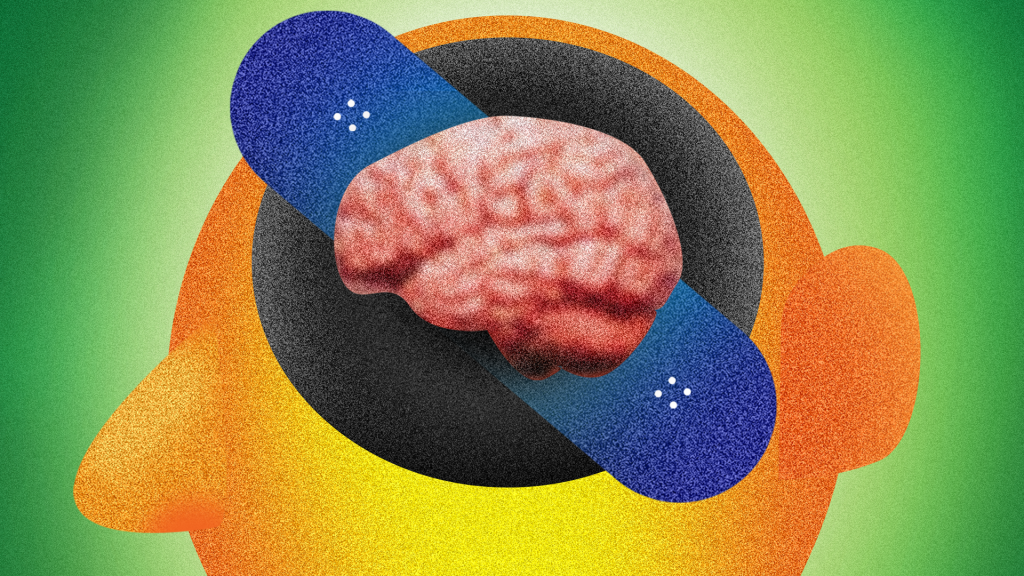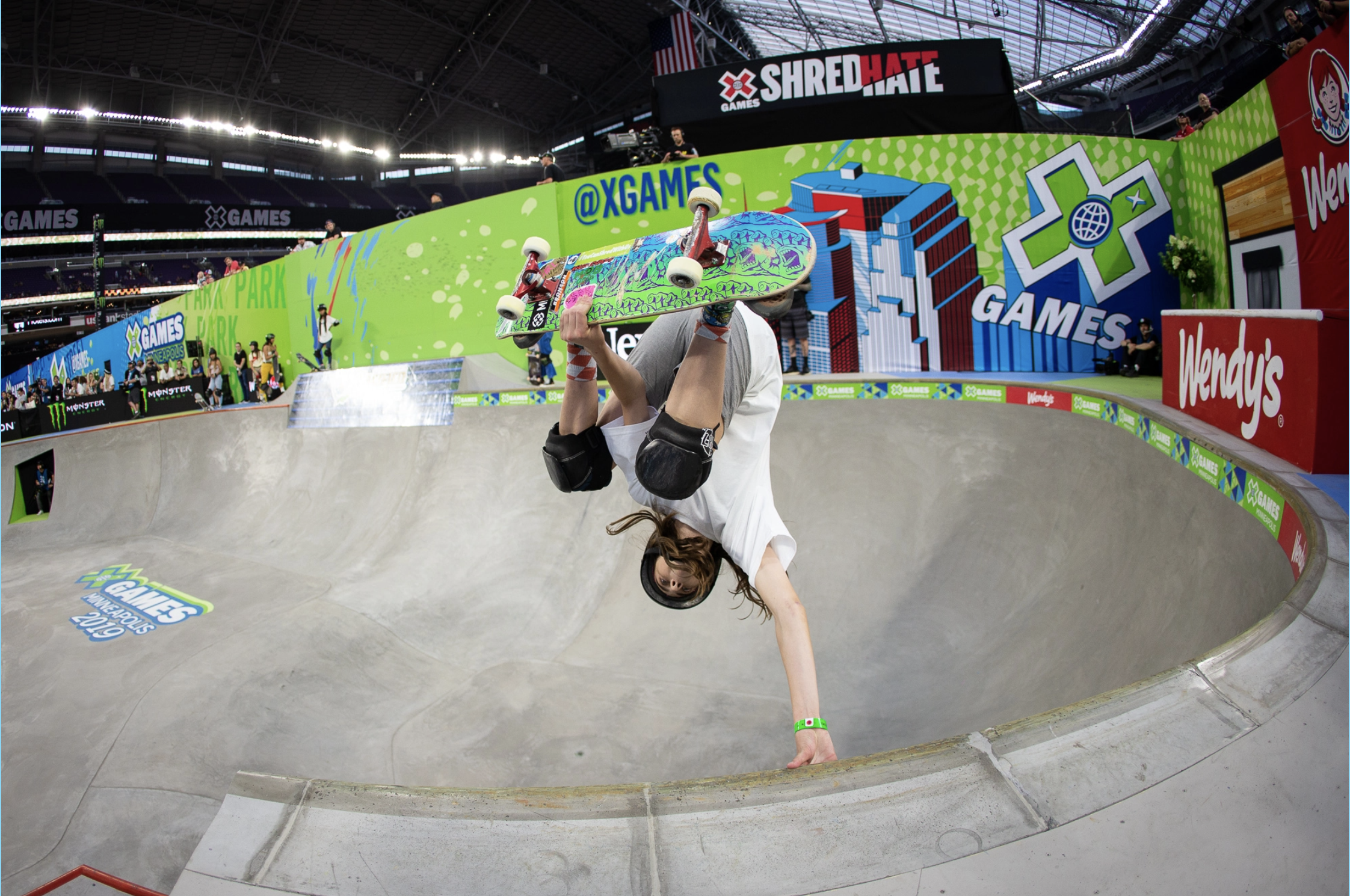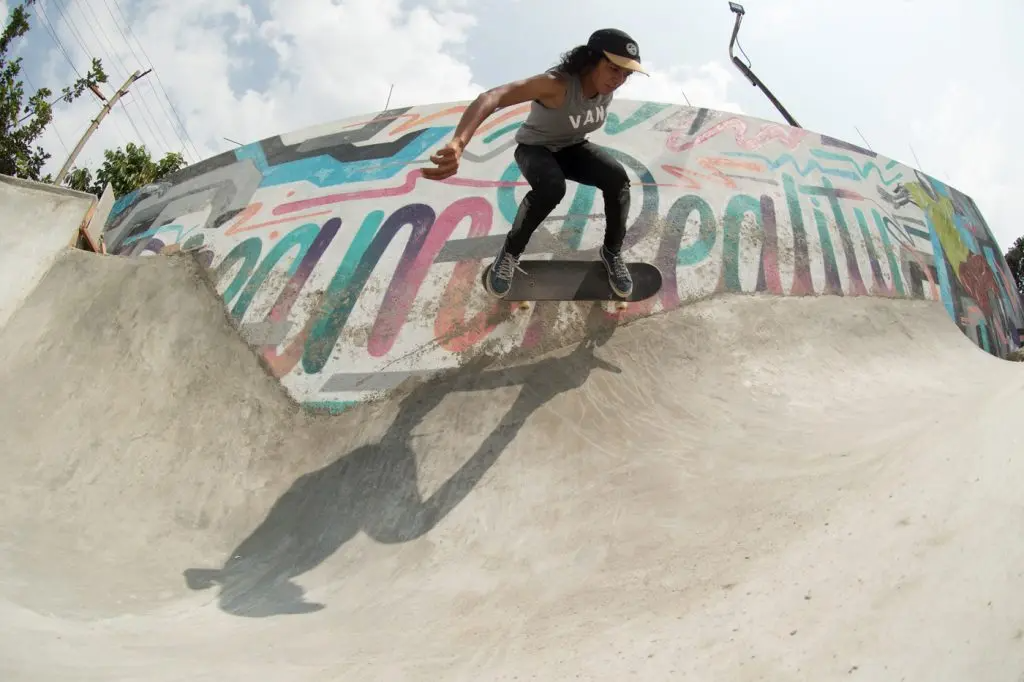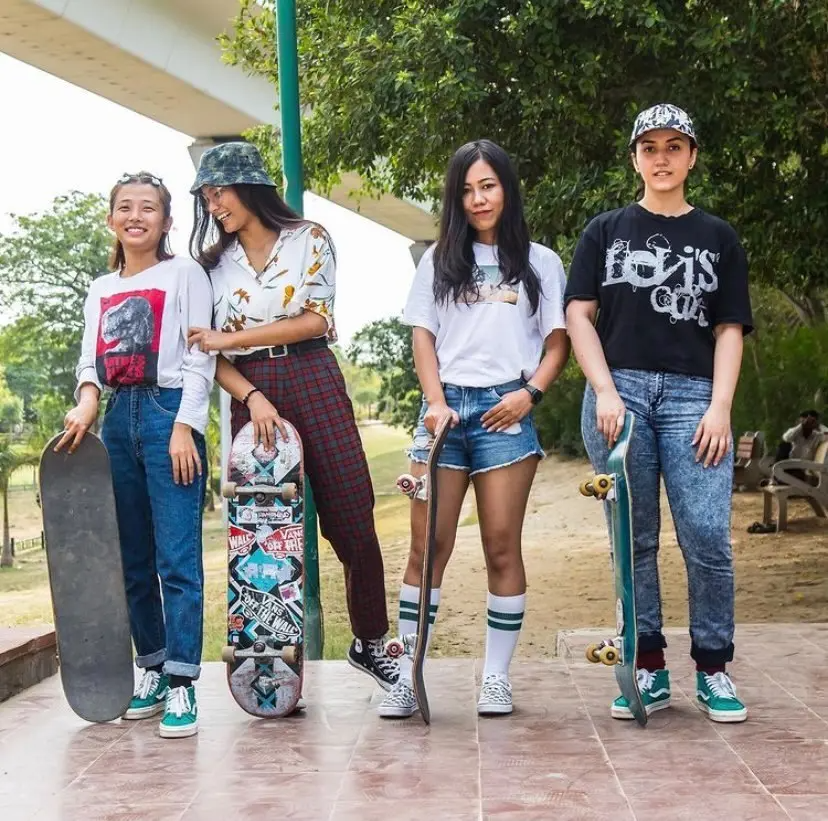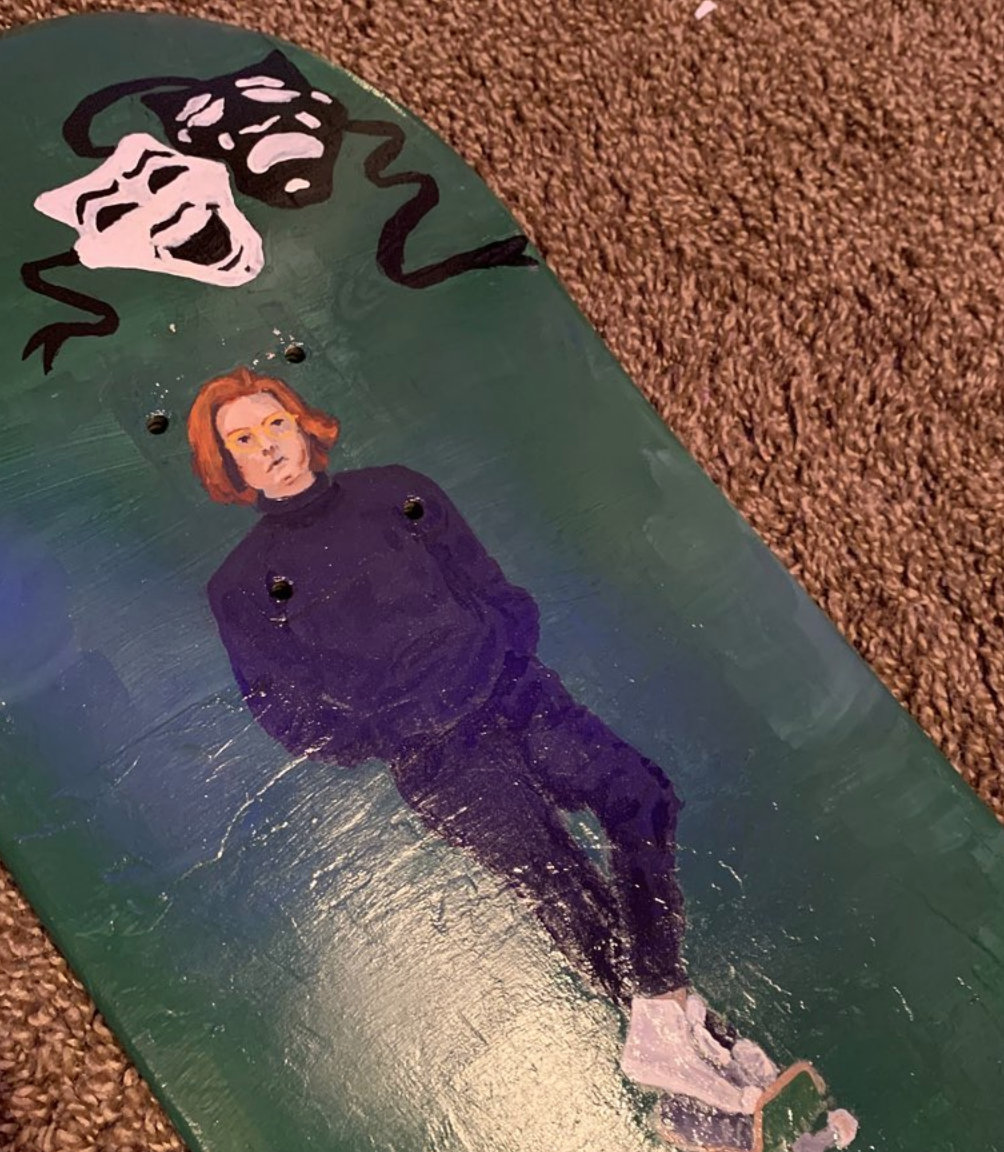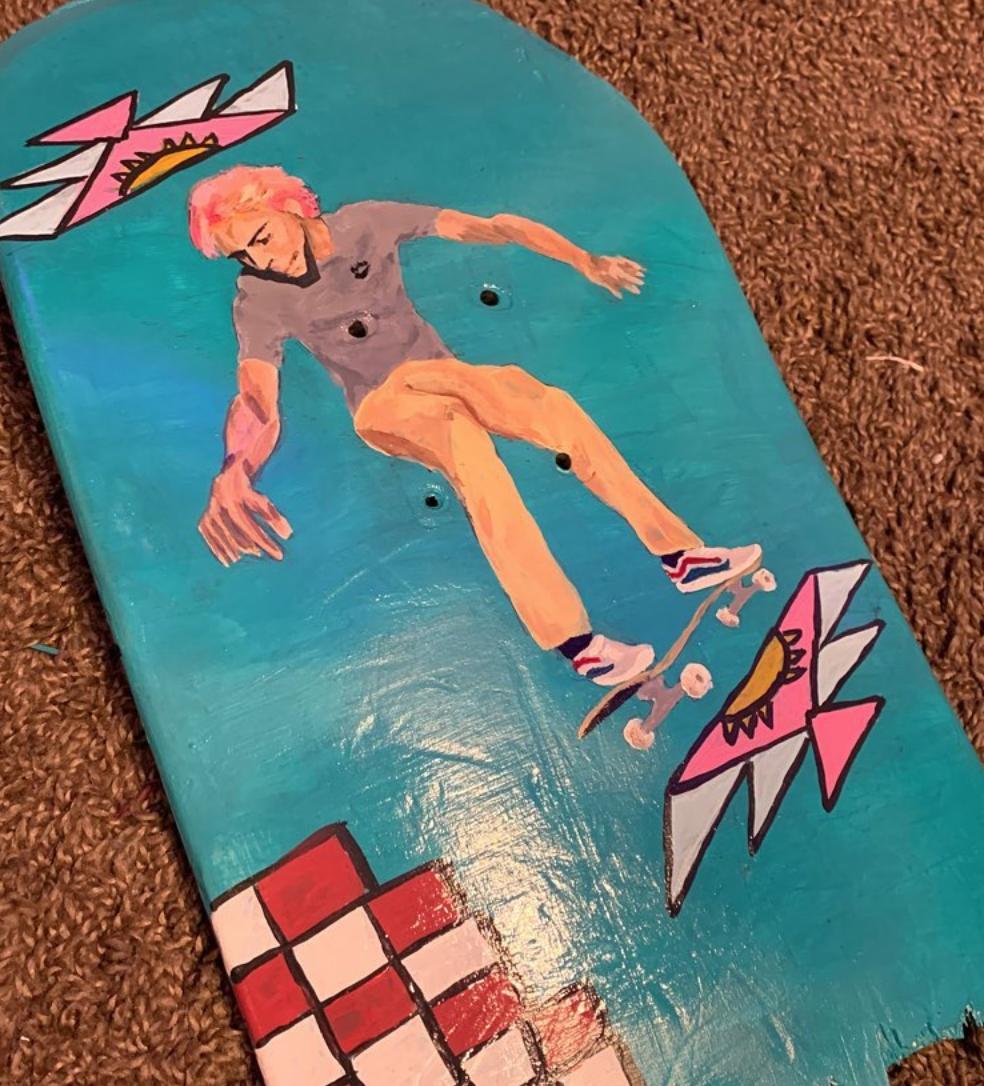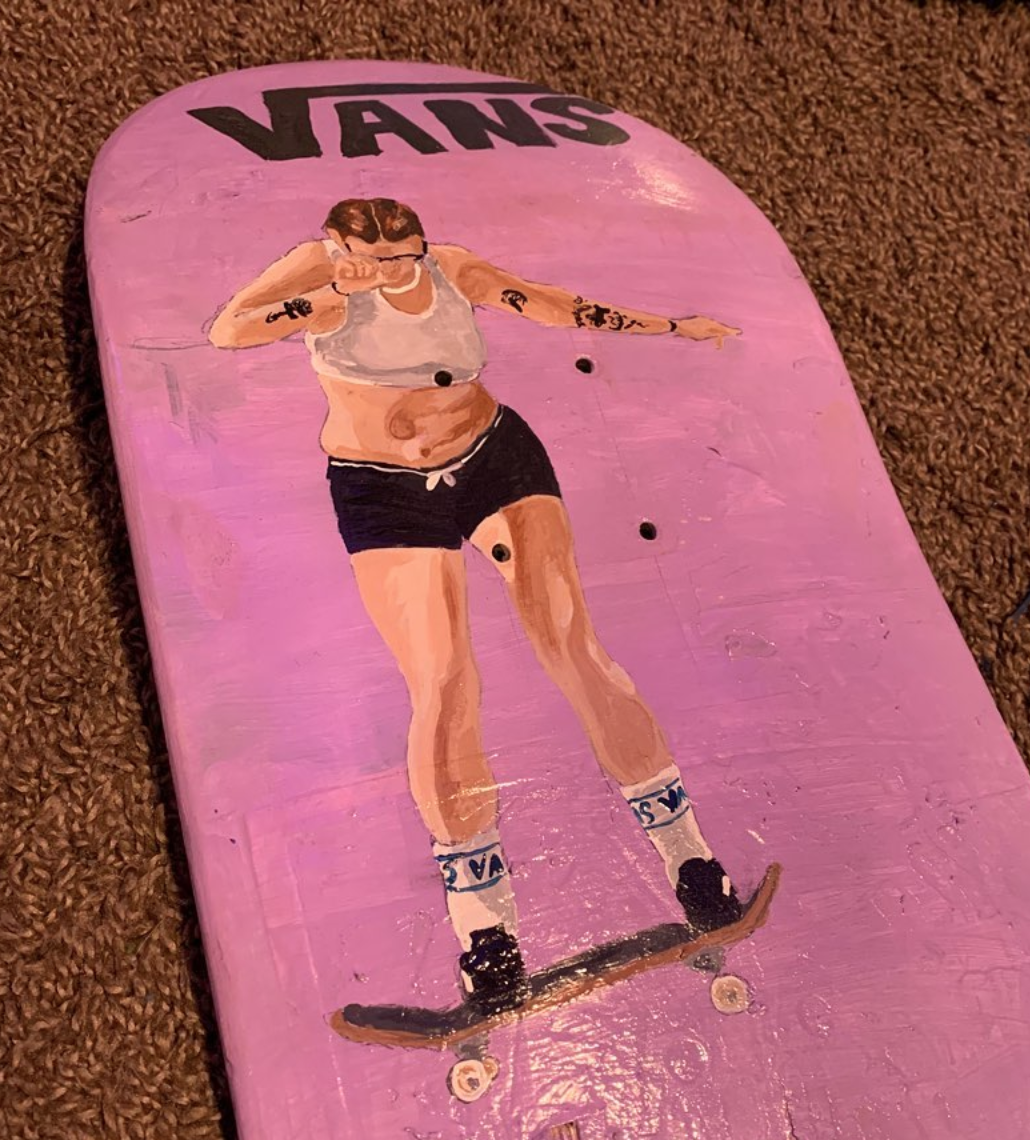How did you start skating, and where did you grow up?
I grew up in Milford Connecticut. When I was 18 or 19, my best friend Ang and I decided we really wanted to start skateboarding. In our town, there weren’t any other girls that were skating so it was a scary journey we were facing together. During it we started an Instagram account called Sk8babes and we were able to meet other girls all over the world. We used our page to connect to other skater girls.
Eventually our followers asked us if we make merch and Ang is a graphic design major and then we made shirts. We used the money to have our first skate clinic to invite all the girls we met on Instagram to skate together. We then started to use the platform to continue that and give other people a platform to give other people recognition.
It’s interesting to hear that so many people start from an Instagram. Social media really changed the game. Quell is like the same way but it’s so crazy to see where you start shipping or who contacts you. How do they even know about this?
You talked about how everything was really organic. Was it your intention to start a business?
That wasn’t my intention at all. I was just posting videos on Instagram and I did not think people would like me like that. Ang and I are both art students and having our own aesthetic and creativity is so much fun.
How would you describe Sk8babes? What is your mission?
I guess Sk8Babes could be considered a “brand” now, but I see it as a platform that I use to encourage, empower, and continue to show the progress being made in not only my own skateboarding journey, but with everyone’s. From people who have just started to the ones skating their whole life.
When you started meetups, when did that take shape into a place that you’d be teaching beginners?
It was a mix. We wanted to make sure we made it clear that it was all skill levels so I think we were trying to teach people. A lot of people were intimidated by skating at skate parks so we wanted to give them that chance. On the other hand we wanted to link with the other skater girls we met.
Ang and I made so many friends just through our Instagram and we all had something in common which was that we wanted to skate without feeling judged or like the outsider. By the time we threw our first clinic we had only met about a handful of other girl skaters in person, yet we had met thousands on Instagram. We decided it was time we brought everyone together and have a day where we can all be at the park feeling free and comfortable, finally getting to skate with people we relate to and not just the cis boys at the park.
I have no idea honestly why we went because I literally never leave my house as you know.
The first was mostly people from New York and Pennsylvania.
Oh yeah we went to literally the first one. I’m so happy we went because it’s been like three years.
Right after that you had a sesh at 2nd Nature!
Right. That’s crazy that that was your first one. There were so many girls there in comparison to who was actually in your Connecticut skate scene.
The first skate clinic was the first time I had been around that many skater girls...but the Quell one. So many ages just killing it and girls everywhere.
It’s interesting how many times like these themes of community and Instagram. I don’t know what compels me to go to Connecticut at 5am but I just did and I feel like so many girls will come up to you at your events and be like I’ve never skated in my life and now I’m at your event.
We’ve hosted many events together and you’re always so positive and uplifting.
What do you look to do when hosting skate events?
I just want everyone to have fun and leave feeling like they were at least a little bit better than when they came in. These events are the perfect opportunity to be yourself and try something new without the anxiety that comes from being at a crowded skatepark on an average day
I wanted to talk to you as a NY resident how that’s shifted your mentality as a business and in skateboarding.
In 2018 I started coming to New York on the weekends. It’s so different but in NY every park I go to there are girls there. I have so many friends here now. It’s so much more of a progressive state. I don’t deal with as much bullshit or people don’t let things slide. I think Connecticut will always mean a lot but it was holding me back.
To your point, people are so accepting and nont racist or homophobic.
I haven’t seen any trump stickers around here but in Connecticut even my neighbors have them.
I imagine the difference in being able to express yourself is so much better.
I don’t think I get harassed as much here. There are so many girls who have my back here.
You do use your Instagram to call people out and speak out. I think it’s so important to hold people accountable.
I know I have a good sized platform. I know people see it. I’m so over just letting ignorance go at this point. I don’t want other people to experience the things I’ve experienced in my early days in skateboarding. Misogyny, harassment. If I can protect some girls, I would do it.
How do you translate that to like events or safe spaces?
No sus people are allowed. I have gone out of my way to make sure people do not show up. I want people to know that they’re safe there without judgement.
I think that comes through. You can tell with Sk8babes stuff that we’re all here for each other. If I’m taking up space I get support and if someone else is taking up space, they get support.
Everyone’s struggle is different but we all have similarities in our struggles.
It’s crazy that we’ve talked about so many things but the catalyst of every relationship is through skateboarding. You have a whole business that you don’t have to skate to support. Skateboarding builds friendships.
It’s the coolest thing in the world.
I wanted to talk to you about your list of Black skaters.
Since I started skating, I remember being a young skater girl on Instagram and there were a few girls skate accounts and some are really popular and a lot post these girls to capitalize off them to get their views and likes. One thing I have noticed is that there’s a lack of representation of Black girls on these skate accounts. It’s just crazy to me especially in NY that I know more women of color skating than white girls. So many Black girls are out here killing it and we’re not getting that representation. These accounts have such a huge platform and can make such a huge impact and they chose not too. So I made a list because people weren’t showing them and I wanted to use my platform to make sure they can also have a platform.
That really inspired me to check what we do here and make sure who we’re following. Are we just posting the same three people too? That’s not diversity either. That list really helped me to make sure as someone who runs these platforms that we don’t post the same things again and again.
I’ve always felt this way about girls skater accounts. The lack of representation was not even there until recently like two months ago. I know there are some accounts that have always been diverse. We see you.
I’m white, I have a lot to learn and we have to be accountable to not fall into patterns and these last two months or whatever it is so important as anyone who runs literally anything. Look around you. I am trying really hard not to move forward in life as someone who isn’t aware.
I don’t feel like these accounts were even aware of this situation. Just based off how society is, they may not have even realized they only pick people who look like them. It’s not that great when you have a big platform.
If you don’t see something that looks like you, why would you pick it up. It takes a lot of internal power-which is why I admire you. You didn’t have people around you that did that.
I was definitely sad sometimes about the lack of feminine energy. I love skateboarding so much. There are no more excuses to have a lack of diversity. I know this community is insanely diverse.
To your point, so many people we’ve featured in this magazine aren’t in like New York or LA. They’re making it happen in these not “big skateboarding cities” so there’s no excuse.
I really wanted to empower others because I didn’t have such a welcome experience in skateboarding. There were some points in skateboarding that I was so sad and down on myself.
As we keep talking about community it's just like friend groups. Not every time you skate is a skate meetup. It could discourage you from skateboarding unless you have friends or someone to skate with.
I love hyping people up. I think a lot of these skater boys forget that it took them a long time to get to the point they’re at now. A lot of them forget we weren’t encouraged to skate at a young age like they were. Skateboarding should be about having fun and every time you skate you’re better than the last time.
There’s so much that can stop you from skating ever again.
Can people stop acting like skateboarding is not hard? It obviously gets easier as time goes on and you progress but it’s not an easy thing to do.
You didn’t just wake up like you got this ollie today and this kickflip tomorrow.
People who are really good at skateboarding put in so much effort to be where they are now.
What do you feel like the future of Sk8babes is?
I want to continue to have meetups and put out merch. Ang and I have a lot of ideas with our next line. I want to keep using my platform for good. Keep skating and encouraging others to do their best.
What advice would you give to someone that wants to start skating?
Know that you probably will be intimidated. You might be scared because everyone has to start somewhere.



